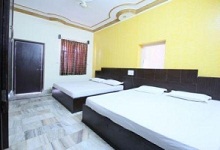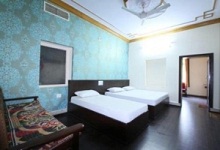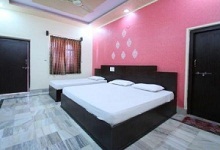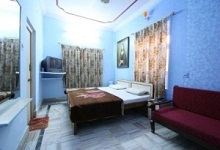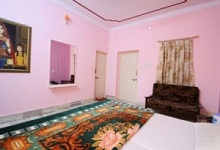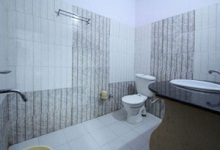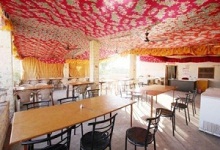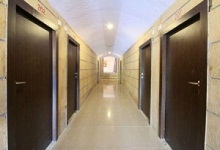JAISALMER
Jaisalmer is a former medieval trading center and a princely state in the western Indian state of Rajasthan. Jaisalmer is also referred as the ‘Golden City’ of Rajasthan. In the year 1156 Maharaja Rawal Jaisal shifted his capital from Lodhruva and established the capital on the top of Trikuta Hills and named it Jaisalmer. The name Jaisalmer derived from its founder King Rawal Jaisal who established the city of Jaisalmer. The word Jaisalmer means ‘The Hill Fort of Jaisal’. Jaisalmer lies at the heart of Thar Desert (The Great Indian Desert) area and is one of the prime tourist destinations in India. The city of Jaisalmer is guarded by Malka to north, to west is Amar Sagar Lake, to the south east is Gadisar Lake. The city of Jaisalmer dates back to around 900 years old. Jaisalmer still retains its medieval charm, which is evident in its colorful narrow streets, splendid forts and palaces of Rajasthan, opulent Haveli and local markets. On the way to Jailsamer from Bikaner a large area of deserts is clearly visible. Desert plants like Jand and Babla mainly grows in this region. During his reign of King Rawal Jaisal, Jaisalmer Fort was built on Trikuta Hills. Jaisalmer is the last district or city of India. Jaisalmer was once the royal seat of Bhatti Rajputs. Jaisalmer, being an arid desert region is prone to extreme temperatures, though the temperature varies greatly from day to night in both summer and winter.
Places of tourists interest around Jaisalmer:
Jaisalmer Fort: Jaisalmer Fort is also known as ‘Sonar Kella’ the name derived from a Bengali film by Satyajit Ray in the 1974. The fort is 460 meter long, 230 meter wide and 76 meter high. An awesome architecture that was built on the deserts. Jaisalmer Fort is believed to be one of the very few ‘living forts’ in the world. As one – fourth of the city’s population resides inside the Fort. Apart from the locals residents many small shops, schools, temples, hotels, curio shops, restaurants are seen inside the fort. In the evening the local Rajasthani singers showcases their folk song and dance as means of entertainment for the tourists. Nestled at an elevation of 80 meter from the plains on the Trikuta Hills and made of Yellow Sand Stones. Jaisalmer Fort and Palace is the second oldest Fort of Rajasthan with walls those are 4 km long, 2 to 3 meter wide and 3 to 5 meter high. The massive yellow sandstone walls are tawny lion colour during the day, but during sunset the colour is fade to honey – gold, thereby camouflaging the fort in the yellow desert. During 12th century King Rawal Jaisal shifted his capital 17 km from Lodhruva to Jaisalmer by the order of his Guru. Jaisalmer Fort has four entrances, among these Akshay Pole is open for tourists and visitors entry and exit. Other three entrances are Suraj Pole (or Sun Pole), Ganesh Pole and Hawa Pole (or Wind Pole). The fort incorporates 99 bastions and guarded by cannons from all sides, that prevents from the entry of the enemies. Beside the cannons there is the view point that offers panoramic view of the whole city of Jaisalmer. There is a Jain temple inside the fort that was built during 12th to 15th century, its architecture and design attracts almost every tourists visiting Jaisalmer Fort. The Juna Mahal, Rang Mahal, Moti Mahal and the Badal Bilas Palace inside Jaisalmer Fort are worth watching. Outside the fort there are shops of Handicrafts and miniature paintings available. Jaisalmer Fort was established in the year 1155. In the year 2013 UNESCO declared Jaisalmer Fort a World Heritage Site.
Royal City Palace: The Royal City Palace is a two-century-old architecture and the most elegant heritage hotels in the city of Jaisalmer located inside the Jaisalmer. The delicate works of art inside the City Palace is worth watching. At present the Royal City Palace is converted into a museum. Inside the City Palace museum tourists get to see the things on display once used by the King Jaisal. The City Palace museum remains open from 08.00 am to 07.00 pm. Apart from the museum, Meghdarbar, Ranidarbar, Dewan-E-Aam, sculptures of 15th century, Rang Mahal and the roof top that also offers panoramic view of Jaisalmer city. From City Palace to the left hand side there are Jain temples constructed around 12th to 15th century. These temples remain open from 06.00 am to 12.00 noon, made of yellow sand stones but the idols are made of white marbel. The delicate art works of Chandraprabhu, Rishavnath, Parshnath, Sitalnath, Sambhubnath, Shantinath and Kunthanath temples are worth watching. Inside the complex of the Jain temples there is Bhinbhadra Suri Knowledge Hub, which is famous for its collection of ancient manuscripts.
Gadisar Lake: During 14th century Maharaja Rawal Jaisal built this lake on a dry land for agricultural purpose later renovated by Maharawal Gadsi Singh. At Gadisar Lake there is a small island, this was the summer escape of the royal family during that time. Later one by one many temples were constructed surrounding this lake and it became a pilgrimage site. During monsoon the lake is fed by rain water. Tourists need to reach the Lake by crossing Toli Ki Pole. Interested tourists can take a boat ride on the lake. During winter numerous migratory birds gathers near the lake. This is one of the oldest lakes at Jaisalmer. The lake was constructed for the purpose of providing water throughout the city of Jaisalmer, as during that period this lake was the main source of water.
Desert Culture Center and Museum: Desert Cultural Centre & Museum exhibits local musical instruments, ancient coins and currency, traditional jewelry of the womenfolk, hunting gear, and historical displays of rulers, artillery and armour. In the evening tourists can enjoy a live puppet show at this place. This Museum remains open from 10.00 am to 05.00 pm.
Folklore Museum: The Folklore museum is a natural history museum lies on the banks of Gadisar Lake in Meher Bagh Garden at Jaisalmer. The museum remains open from 08.00 am to 06.00 pm.
Bada Bagh: Located around 06 km north from the city of Jaisalmer. At Bada Bagh there are rows of cenotaphs of the royal family members. These cenotaphs are made of yellow sand stone and each differs in size and architecture.
Amar Sagar: Amar Sagar Lake is situated 7 km from the western boundaries of Jaisalmer in Rajasthan. It is a lake and oasis located next to the Amar Singh Palace which was made in the 17th century, it remains open from 08.00 am to 08.00 pm.
Lodhruva or Lodrawa: Located around 16 km from the city of Jaisalmer to the North West side. This is the ancient capital of Jaisalmer. It is popular among tourists for its architectural ruins, sand dunes and Jain temple. It remains open from 07.00 am to 06.00 pm.
Government Museum: This museum has huge collections of marine and wood fossils along with the daily useable things like crockery, jewelry of 07th to 09th century. This museum remains open from 10.00 am to 04.00 pm every six days a week except Friday.
Temple Palace or Tajiya Tower: The five storey Badal palace was converted into a pagoda type Tajiya Tower on addition of more floors to it. It is an example of the Islamic architecture at Jaisalmer. This five storey high tower is located near Badal Palace (Megh Mahal). Every floor of this tower is beautifully decorated with artistic excellence.
Sam Sand Dunes of Thar Desert: The Sam Sand Dunes of Thar Desert is a large arid region in the northwestern part of the Indian subcontinent and one of the main attractions at Jaisalmer. Spread over area of about 170000 sq km with dense sand. The Sam Sand Dunes is regarded as top 10 must visit tourist spots in Rajasthan by Lonely Planet travel magazine, the sand dunes of Jaisalmer is a rare desert area, lying on the borders of Jaisalmer Desert National Park. Tourists can opt for a camel’s back ride which is a lifetime experience or a jeep safari on the desert area. Sam Sand Dunes or Thar desert is located around 42 km from the city of Jaisalmer. Throughout the desert long stretches of sand are interspersed by sand hillocks, sand dunes and gravel plains. The Sudhashri Forest Post is the best location for the panoramic view of the Thar Desert. Some of the wildlife species inhabited this region of Thar desert are Chinkara deer (also known as Indian Gazelle), Black Buck (or Indian Antelope), wolf, desert fox, rabbits and desert cats. A visit to the Sam Sand Dunes during sunset is a worthwhile experience. The best time to visit the desert is 04.00 am to 06.00 am and 04.00 pm to 07.00 pm.
Kuldhara Village: Kuldhara is an abandoned village located around 18 km from Jaisalmer. Though established around 13th century Kuldhara was once a habitat of the Palwala Brahmins but during the early 19th century the Brahmins left the village abandoned. At present only the ruins of the village exist. It is declared as a heritage village and tourist spot by the government of Rajasthan.
Khuri Village: This pristine desert village is located 40 km southwest of Jaisalmer. This lesser known serene village is mostly inhabited by the tribal people. The main attraction of Khuri Village is for its Sand dunes along with the arts and crafts of the local artisans of the village. This unexplored desert village is still unknown to many tourists thereby makes it an isolated spot around Jaisalmer. Though the scenic landscape is much better in comparison to the Sam Sand Dunes of Thar desert, still the number of tourist visit are much lesser at Khuri Sand Dunes. Tourists can enjoy the desert safari on a camel’s back. In the evening the locals of the village showcases tribal folk dance and song, the songs performed by the locals are known as ‘Kalbeliyas’. From Jaisalmer station by car it takes around 40 minutes to reach Khuri village.
Tanot Rai Temple: The Tanot Rai temple is located 122 km to the north west of Jaisalmer. The idol in the temple is an incarnation of Hinglaj Mata. From the temple around 15 km is Kisan Garh border, tourists are required to arrange the necessary documentation and permits. On the way tourists will come across Ramgarh Army camp, Indira Canal, Ghantewali Durga temple and Tanot entry gate (built in the memory of Indo – Pak war on 1965). From Tanot Rai Temple the left hand side route around 32 km is Longewala (it is also a desert area). Longewala is famous for the Indo – Pak trunk war which was held during 1965 to 1971. Till date many abandoned trunks are seen on the desert. This area has a high average wind speed as a result numbers of wind based renewable energy projects are seen here.
Wood Fossils Park or Akal Fossils Park: This Park is located around 17 km from Jaisalmer on the way to Barmer. This park has the collection of fossil trees those dates back to the Jurassic age. Each collections of this park dates back to around 180 million years. The largest fossils in this park measures upto 13 meter. The park lies in Jaisalmer’s fossil belt, a region noted to have high potential for geological importance. Fossils and footprints of pterosaurs have been unearthed in the nearby Thaiyat area.
Haveli or Palaces at Jaisalmer: A Haveli is a traditional townhouse or mansion in the Indian subcontinent, usually one with historical and architectural significance. Jaisalmer has a number of Haveli or palaces those attract tourists for their architecture, glass painting and the delicate works of the interiors and exterior as well. Some of these are described below. Each Haveli at Jaisalmer has its own Dewan-E-Aam, guest house, kitchen, basement, and staircase and wall chest. All these palaces are maintained by the archeological department of India.
Salim Singh Ki Haveli: This is the Haveli of the then prime minister during the reign of King Rawal Gaj Singh. This palace dates back to around 300 years. Till date the present generation of Prime Minister Salim Singh lives here. The main attractions of this Haveli are its arched roof with superb carved brackets in the form of peacocks and the top storey spreads out into a mass of carving, with graceful arched balconies surmounted by pale-blue cupolas.
Patwa Ki Haveli: The Patwa Ji ki Haveli is an interesting piece of architecture and is the biggest, ostentatious and the most beautiful palace of all in Jaisalmer, situated in a narrow lane. It is not a single Haveli but a cluster of 5 small Havelis, built during 19th century by Guman Chand Patwa. This place was the residence of the erstwhile rich traders of Jaisalmer the Patwas. The glass work and the museum inside the Haveli gives people a chance to revisit the old days and experience the lifestyle of erstwhile Patwas. The artistic works in each corner are designed with delicate wall art, be it gracefully carved pillars or the facade or the balconies (Jharokhas). The doors are decorated with ivory, the walls and the roof are decorated with gold and the stone carved meshes (Jafris) decorated with Belgium glass.
Nathmal Ki Haveli: This Nathmal Ji ki haveli was commissioned to serve as the residence of Diwan Mohata Nathmal, the then Prime Minister of Jaisalmer. Maharawal Beri Sal commissioned the construction of this Haveli. Built during 19th century, the Haveli remains open from 08.00 am to 05.00 pm. Built by two brothers. The main attractions of this palace are the replicas of two elephants made of yellow sand stone placed at the entrance. Among the two brothers, one brother built the left side of the palace and another brother built the right side of the palace. But still both the sides are similar to each other. The miniature paintings engraved on the walls of the palace attract every tourist.
Barmer: Located around 154 from Jaisalmer, by bus or car it takes about 2.5 hours. The handicraft arts of Barmer are worth watching.
Desert Festivals: Every year Jaisalmer hosts many deserts festivals which are the most awaited and famous cultural events of Rajasthan. Some of these are Camel races, Turban – Tying. These festivals are organized during January – February, the festivals showcases Rajasthani Folk dance and song. Gair and Fire dance are the major attractions. The Kalbeliya dance and folk song are among the most awaited in Jaisalmer.
Shopping around Jaisalmer: Jaisalmer is famous for its miniature arts, Rajasthani sarees those are decorated with small pieces of glass and the most famous are utensils made from sand stone which are available locally and are crafted very delicately. Few places of shopping include the Central Park and the Rajasthani Emporium.
Reaching there:
By Rail – Jaisalmer is well connected by strong rail networks with all tourist destinations around Rajasthan and also with other major cities of India. Some of the rail networks are noted below. 12468 Lilan Express leaves Bikaner at 11.15 pm and reaches Jaisalmer the next day 4.50 am. From Howrah Jnc 12371 Jaisalmer express leaves every Monday. 14810 Jodhpur – Jaisalmer express leaves Jodhpur at 11.45 pm and reaches Jaisalmer the next day at 06.00 am. 4059 Delhi – Jaisalmer express leaves Jodhpur 06.20 am and reaches Jaisalmer at 01.00 pm, 4810 Jodhpur – Jaisalmer express leaves Jodhpur at 11.25 pm and reaches Jaisalmer next day at 05.30 am.
By Air –Jaisalmer is well connected by flight service with other major destinations in Rajasthan and major cities of India like Delhi, Mumbai, Kolkata, Jaipur, Surat, Ahmedabad and others. Jaisalmer airport is located 17 km southeast of Jaisalmer city.
By Surface or Road –Jaisalmer is well connected with strong motorable roads with other destinations of Rajasthan and India as well. Direct buses ply from Jaisalmer and reach other tourist destinations around Rajasthan.
Best time of visit: April to May is the pre – monsoon season or summer season. July to September is the monsoon period which sees rainfall. October to November is the post – monsoon season when the climate is pleasant. December to March is the winter season.
Distance of other tourist spots from Jaisalmer:
Jaisalmer to Jodhpur – 285 km
Jaisalmer to Bikaner – 332 km
Jodhpur to Ajmer – 490 km
Jodhpur to Jaipur – 555 km
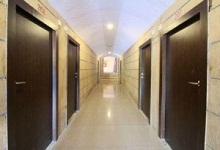

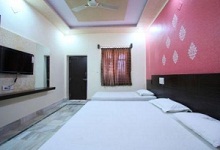

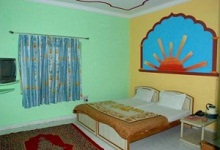
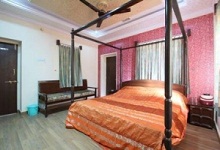
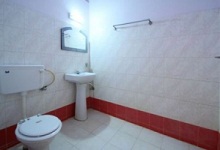
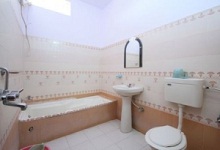

HOTEL PRINCE
Hotel Prince is one of the prime accommodations available at Jaisalmer. Hotel Prince Offers a picturesque view of the sand dunes and desert from its periphery. Hotel Prince is a budget accommodation with all the modern amenities available for the tourists. Hotel Prince is equipped with a roof top restaurant from where tourists can enjoy the beauty of Jaisalmer fort, the Royal City Palace, and the city itself. The restaurant offers traditional foods along with continental foods.
Amenities available:
Well furnished rooms with attached bathrooms.
Toilets are of western type toilets in all the rooms.
All rooms are designed in traditional manner.
Offers luxurious stay for tourists at a budget cost.
Doctor on call.
LED T.V. in all the rooms.
Pick up and drop facility on request (paid service)
Travel assistance and arrangement of local sight tour.
Restaurant facility available.
Room Tariff:
Double Bed Rooms @ 1400/-
Deluxe Rooms @ 1600/-
Super Deluxe Rooms @ 1800/-
Four Bed Rooms @ 2000/-
Family Rooms @ 2200/-
Service charge as applicable on the room tariff.
GST if any applicable on the room tariff.
HOW TO BOOK: Call us at 9831311606 , 9830381306, 9830619422, 9831208172 to get the current availability status or use the query form furnished below with all you travel queries and submit, we will call/ contact you directly.
Or, you may also directly book from our Kolkata office at: 8C Shanti Ghosh Street, Kolkata – 700003. Nearest Landmark: Manindra Chandra College and Shyambazar Metro Railway Station (Gate No: 3)
